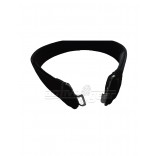Details
The mace derives from the medieval weapon of the same name. It was composed of a spiked head attached by a chain to a wooden handle. The mace was swung around the head to clear a path or to strike an unhorsed opponent. Historically, the drum was an important tool used in war, some persons may even suggest that a war was not a war until there was a drummer present on the battlefield, and who leads the drummers?, the Drum Major of course, with his Mace as his primary instrument of authority. The Mace was introduced into the British Army in the 18th century. The Drum Major would instruct the drummers in certain beatings which would communicate messages to the troops in battle, which in turn would direct fire and concentration at the enemy. He had to get it right first time or the battle might be lost, hence drum Majors are usually held in high esteem by bother Officers and Other ranks alike. Most regiments (active or otherwise) usually designate a particular Mace as the regimental mace. It is customary for the Regimental Mace to carry the Regimental or Unit title, badge, devices and on occasions Battle Honours, inscribed around the head.
There are lighter cane maces that are favored by world-class competition drum majors. Malacca cane maces tend to be weighted differently and are heavier than fiberglass maces. Malacca cane maces complete "the look" of a pipes and drums or regimental drum major. Unfortunately, they can be quite expensive and hard to come by. Fiberglass shaft maces are very common, particularly among high school and college drum majors. They are inexpensive, repairable and there are many easily found distributors. Some feel that fiberglass maces are harder to flourish than Malacca cane maces. Drum majors use different maces and crown domes on different occasions. When a drum major is practicing the routine that he or she will perform before the band begins to play, he or she typically will use a plain dome atop the mace. These performance routines often involve the drum major twirling the mace, throwing the mace up into the air to spin and catching the mace before it hits the ground. As they march, drum majors will move their maces in rhythm with the paces they set for their entire bands. This enhances the military look and regimented feel of the bands for the parade audience. It also allows each drum major mace to act as a conductor's baton, because the band behind the drum major can ensure that they are marching and playing at the right pace by observing the rhythm of the mace.
Tips for Drum Majors:
- The finial can be changed to alter the balance.
- The ferrule can be changed to alter the length of the mace.
- Cords can look just as good as chains but make sure you don't get thick ones laden with tassels. These slow the mace down as it turns (drag factor).
Additional Information
| size | No |
|---|
You may also be interested in the following product(s)
-

Shoulder Sashes
$49.99 -

Courlene Belt
$19.99





